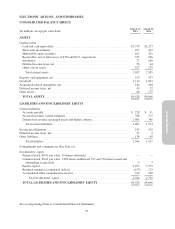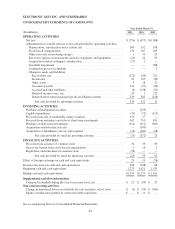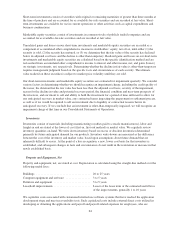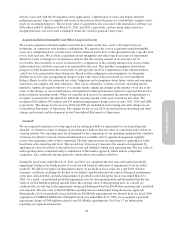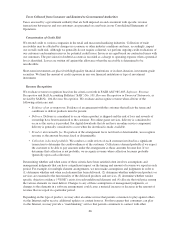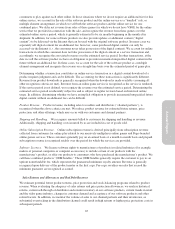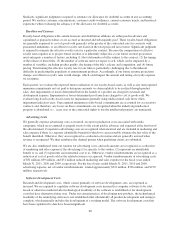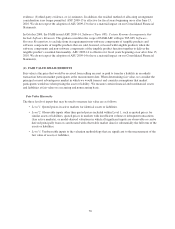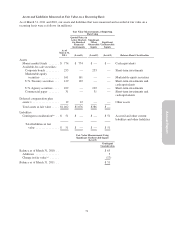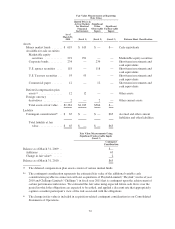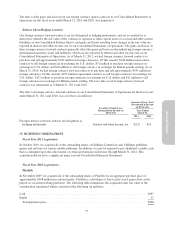Electronic Arts 2011 Annual Report Download - page 145
Download and view the complete annual report
Please find page 145 of the 2011 Electronic Arts annual report below. You can navigate through the pages in the report by either clicking on the pages listed below, or by using the keyword search tool below to find specific information within the annual report.
Annual Report
Stock-Based Compensation
We are required to estimate the fair value of share-based payment awards on the date of grant. We recognize
compensation costs for stock-based payment awards to employees based on the grant-date fair value using a
straight-line approach over the service period for which such awards are expected to vest. The fair value of
restricted stock units and restricted stock is determined based on the quoted market price of our common stock on
the date of grant. The fair value of stock options and stock purchase rights granted pursuant to our equity
incentive plans and our 2000 Employee Stock Purchase Plan (“ESPP”), respectively, is determined using the
Black-Scholes valuation model. The determination of fair value is affected by our stock price, as well as
assumptions regarding subjective and complex variables such as expected employee exercise behavior and our
expected stock price volatility over the expected term of the award. Generally, our assumptions are based on
historical information and judgment is required to determine if historical trends may be indicators of future
outcomes. The key assumptions for the Black-Scholes valuation calculation are:
•Risk-free interest rate. The risk-free interest rate is based on U.S. Treasury yields in effect at the time of
grant for the expected term of the option.
•Expected volatility. We use a combination of historical stock price volatility and implied volatility
computed based on the price of options publicly traded on our common stock for our expected volatility
assumption.
•Expected term. The expected term represents the weighted-average period the stock options are expected
to remain outstanding. The expected term is determined based on historical exercise behavior, post-
vesting termination patterns, options outstanding and future expected exercise behavior.
•Expected dividends.
Employee stock-based compensation expense is calculated based on awards ultimately expected to vest and is
reduced for estimated forfeitures. Forfeitures are revised, if necessary, in subsequent periods if actual forfeitures
differ from those estimates and an adjustment to stock-based compensation expense will be recognized at that
time.
Changes to our assumptions used in the Black-Scholes option valuation calculation and our forfeiture rate, as
well as future equity granted or assumed through acquisitions could significantly impact the compensation
expense we recognize.
Foreign Currency Translation
For each of our foreign operating subsidiaries, the functional currency is generally its local currency. Assets and
liabilities of foreign operations are translated into U.S. dollars using month-end exchange rates, and revenue and
expenses are translated into U.S. dollars using average exchange rates. The effects of foreign currency translation
adjustments are included as a component of accumulated other comprehensive income in stockholders’ equity.
Foreign currency transaction gains and losses are a result of the effect of exchange rate changes on transactions
denominated in currencies other than the functional currency. Net foreign currency transaction gains (losses) of
$12 million, $(19) million, and $(49) million for the fiscal years ended March 31, 2011, 2010 and 2009,
respectively, are included in interest and other income, net, in our Consolidated Statements of Operations.
Impact of Recently Issued Accounting Standards
In October 2009, the FASB issued Accounting Standards Update (“ASU”) 2009-13, Revenue Recognition (Topic
605):Multiple-Deliverable Revenue Arrangements. This guidance modifies the fair value requirements of FASB
ASC subtopic 605-25, Revenue Recognition-Multiple Element Arrangements, by allowing the use of the “best
estimate of selling price” in addition to vendor-specific objective evidence and third-party evidence for
determining the selling price of a deliverable for non-software arrangements. This guidance establishes a selling
price hierarchy for determining the selling price of a deliverable, which is based on: (a) vendor-specific objective
69


